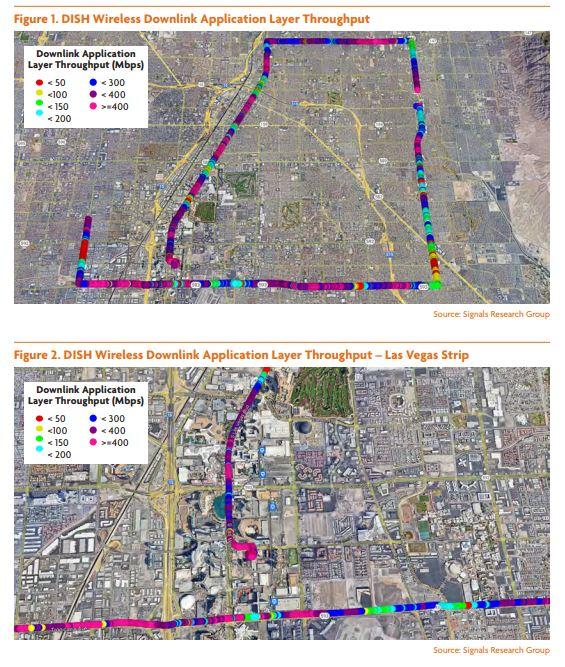A new study by Signals Research Group (SRG) shows marked advances in Dish Network’s 5G network in Las Vegas compared to a year ago.
“The downlink is much better than it was last year,” said Mike Thelander, president and founder of SRG. “It still falls a little bit short of what you might expect,” but as SRG’s latest report suggests, the network performance is a matter of “night and day” compared to a year ago.
‘Some flaky things’ in 2022
When SRG conducted tests in 2022, they didn’t have the ability to log chipset data, which limited their ability to analyze the data. Still, “we had enough insight to know there were some flaky things going on with how they used carrier aggregation,” Thelander told Fierce.
For example, the throughput would “fall off a cliff” when trying to do a cell handover. “It was just all over the map,” he said. Calls switched to the AT&T network too often. In addition, the density of Dish’s network at that time was pretty light, which impacted performance.
Since then, Dish has launched 3 carrier aggregation (CA), and the throughput on the downlink is much more consistent and higher than it was in 2022, Thelander said. SRG recorded an average data speed of 307 Mbps and nearly 500 Mbps at the 90th percentile, or more than 2x higher than they observed in 2022.
As for voice quality, “it was a lot better, but room for improvement,” he said. Compared with T-Mobile’s Voice over New Radio (VoNR) in the same market, Dish’s 5G VoNR didn’t stack up. “It wasn’t bad. It just wasn’t as good,” he said.
Last year, they tested Dish’s network in stationary positions and call quality was highly erratic; it was even worse when driving around.
“This year, it wasn’t by any means perfect, but we stayed on Dish the entire time we tested, so they’ve definitely built out their network” and there’s no need to hand off to MVNO partner AT&T like it did last year. “The quality of voice was good. I wouldn’t call it as good as T-Mobile’s.”
Concerns about uplink
The biggest area needing improvement is in the uplink performance, he said.
SRG tested with the UDP and HTTP protocols. The UDP is more video-centric. HTTP is more about sending emails or documents, he said, and that’s where they saw problems. “It was not good, and that’s being nice. It was bad last year and it hasn’t gotten any better. So that was a concern … Whatever is causing the problem, it wasn’t good,” he said.
Dish recently announced a technical breakthrough with Qualcomm and Samsung that sets the scene for faster download and upload speeds. The test was done in both Dish labs and in the field, and Dish said it will soon benefit Boost Mobile and Boost Infinite customers.
Dish is the first in the U.S. with a network built entirely on open Radio Access Network (RAN) technology and prides itself in its cloud-native approach. It was the first U.S. operator to launch a 5G voice service, or VoNR, going live in Las Vegas last year, and it’s been steadily increasing VoNR functionality in additional markets.
Dish is using Mavenir for its centralized unit (CU) and decentralized unit (DU) deployment and Fujitsu for the radio units (RU). Ericsson is the RAN vendor for T-Mobile in Las Vegas. SRG conducted its tests using two Motorola Edge + smartphones and two Samsung Galaxy A23 smartphones to collect data on the Dish Wireless network. Accuver Americas, Rohde & Schwarz and Spirent Communications provided test equipment and platforms.
SRG said they’d like to claim they did an open RAN benchmark study “since it would generate a lot of buzz,” but the reality is they “merely tested a multi-vendor RAN deployment” in Las Vegas. The report noted that “we’re not even sure what an Open RAN benchmark study would look like since testing the various Open RAN interfaces is really about conformance and not performance.”

The tests by SRG primarily focused on Band n70 for Dish and Band n25 for T-Mobile, which are both in the 1.9 GHz range, offering a more apples-to-apples comparison than mixing up or using other spectrum bands.
One reason to focus on Las Vegas now is it was Dish’s first market. Plus, SRG analysts just happened to be in the city for MWC 2023 in September. Thelander said where he lives in Minnesota, Dish provides the second-best performance behind Verizon. He’s not going to switch, but “they can offer a pretty satisfactory service.”
SRG’s report said they made Dish aware of their plans to test its network but ended up being solely responsible for all logistics, including device procurement, SIMs, et cetera. By “going it alone,” SRG said it gained insight into some of the limitations of the current subscriber procurement and device provisioning processes.
Fierce reached out to Dish for comment and will add to this story with any updates.
